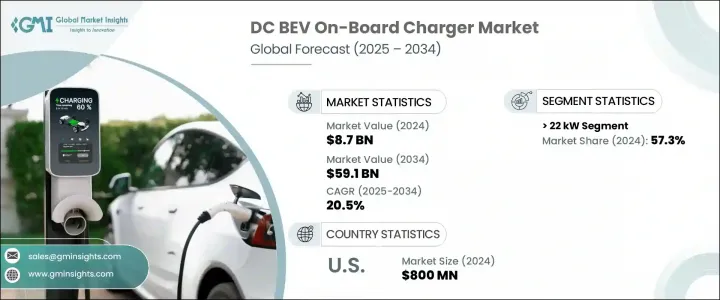
세계의 DC BEV 온보드 차저 시장 규모는 2024년에 87억 달러로 평가되었고, CAGR 20.5%로 성장할 전망이며, 2034년에는 591억 달러에 이를 것으로 예측됩니다.
이 성장의 원동력이 되고 있는 것은 세계에서 전기자동차의 보급이 진행되고 있는 것, EV 충전 인프라가 계속적으로 진보하고 있는 것입니다. DC 차저는 그리드 기반 교류 전력을 직류 전력으로 변환해 보다 효율적이고 편리한 배터리 충전을 가능하게 하기 때문에 배터리 전기 자동차(BEV)에 중요합니다. 성능, 항속거리, 충전속도에 대한 요구가 높아짐에 따라 그 중요성이 커지고 있습니다.

환경 의식 증가, 배출 가스 규제 강화, 정부의 인센티브 확대가 시장의 궤도를 총체적으로 강화하고 있습니다. 자동차 제조사와 시스템 공급자는 고효율 양방향 충전과 같은 차세대 기능을 갖춘 소형 및 경량 DC 차저에 주목하고 있습니다. 세계의 EV 판매가 급증함에 따라 고도로 통합된 다기능 직류 충전 시스템의 필요성이 더욱 명확해지고 있습니다. 시장 진입 기업은 또한 충전 네트워크의 일관성과 사용자 경험을 높이기 위해 보편적인 호환성과 업계 표준 설계 접근 방식을 중시합니다. BEV 카테고리에서는 시스템의 크기와 중량을 최소화하는 것이 매우 중요하며, 특히 최적의 항속거리와 성능을 우선시하는 차량에서는 DC 차저가 EV의 폭넓은 이행에 점점 더 필수적입니다.
| 시장 범위 | |
|---|---|
| 시작 연도 | 2024년 |
| 예측 연도 | 2025-2034년 |
| 시작 금액 | 87억 달러 |
| 예측 금액 | 591억 달러 |
| CAGR | 20.5% |
22kW 이상의 고출력 DC 차저는 2024년 57.3%의 점유율을 차지했습니다. 이러한 시스템은 급속 충전을 지원하는 능력을 인정받고 있으며, 까다로운 용도에서 사용하기에 선호됩니다. 개발 업체는 온보드 차저의 구성을 예상 고속도로의 급속 충전 인프라 정비에 맞추고 있습니다. 이러한 차저의 더 큰 출력 능력은 자동차 제조업체가 더 빠른 충전 시간과 더 나은 운전 편의성을 제공하는 것을 지원하며, 이는 중요한 경쟁 우위가 되고 있습니다.
미국의 DC BEV 온보드 차저 2024년 시장 규모는 8억 달러로 평가되었습니다. 견고한 EV 보급률, 급속한 인프라 개발, 청정 교통 솔루션에 대한 연방 및 주 차원의 지원 증가가 북미 시장의 급 가속화에 기여하고 있습니다. EV 제조업체와 에너지 솔루션 제공업체 간에 소비자와 규제 당국 모두의 기대에 부응하는 보다 빠르고 유연한 충전 시스템을 통합하려는 기운이 커지고 있습니다.
DC BEV 온보드 차저 시장을 형성하는 주요 기업으로는 Toyota Industries Corporation, Valeo, Powell Industries, Kirloskar Electric Company, Eaton Corporation 등이 있습니다. 이러한 주요 기업들은 진화하는 시장 요구에 대응하기 위해 적극적으로 기술 혁신을 추진하고 생산 규모를 확대하고 있습니다. 대기업은 전력 밀도가 높고 열출력이 낮은 차세대 소형 충전기 개발 등 전략적 제품 혁신에 주력하고 있습니다. 각 회사는 차량 대 그리드(V2G) 통합 및 스마트 에너지 관리를 위한 양방향 기능을 통합하기 위한 연구 개발에 투자하고 있습니다. 많은 기업들은 시스템의 상호 운용성과 차량 플랫폼과의 원활한 통합을 보장하기 위해 EV 제조업체 및 인프라 제공업체와 제휴를 맺고 있습니다. 또한 시장 리더 각사는 제휴 및 인수를 통해 세계적인 사업 전개를 진행하는 동시에 비용 절감 및 공급망의 강인성 강화를 위해 현지 생산을 강화하고 있습니다.
The Global DC BEV On-Board Charger Market was valued at USD 8.7 billion in 2024 and is estimated to grow at a CAGR of 20.5% to reach USD 59.1 billion by 2034. This growth is being fueled by the rising adoption of electric vehicles across the world and the continuous advancement in EV charging infrastructure. DC on-board chargers are critical to battery electric vehicles (BEVs) as they convert grid-based AC power into DC power, enabling more efficient and convenient battery charging. Their importance grows as the demand for performance, range, and speed of charging continues to climb.

Increasing environmental awareness, stronger emissions regulations, and expanded government incentives are collectively strengthening the market's trajectory. Automakers and system providers are focusing on compact, lightweight DC chargers with high efficiency and next-gen capabilities like bidirectional charging. As global EV sales surge, the need for highly integrated and multifunctional DC charging systems is becoming more evident. Market participants are also emphasizing universal compatibility and industry-standard design approaches to enhance charging network consistency and user experience. In the BEV category, minimizing system size and weight is crucial, especially for vehicles that prioritize optimal range and performance, making DC chargers increasingly essential to the broader EV transition.
| Market Scope | |
|---|---|
| Start Year | 2024 |
| Forecast Year | 2025-2034 |
| Start Value | $8.7 Billion |
| Forecast Value | $59.1 Billion |
| CAGR | 20.5% |
The High-power DC chargers rated above 22 kW segment held a 57.3% share in 2024. These systems are recognized for their ability to support fast charging and are favored for use in demanding applications. Manufacturers are aligning their on-board charger configurations with anticipated highway fast-charging infrastructure developments. The greater power capabilities of these chargers support vehicle manufacturers in delivering quicker charging times and better driving convenience, which is becoming a key competitive advantage.
U.S. DC BEV On-Board Charger Market was valued at USD 800 million in 2024. Strong EV adoption rates, rapid infrastructure development, and growing federal and state-level support for clean transportation solutions have all contributed to the market's rapid acceleration in North America. There is growing momentum among EV manufacturers and energy solution providers to integrate faster, more flexible charging systems that meet both consumer and regulatory expectations.
The leading companies shaping the DC BEV On-Board Charger Market include Toyota Industries Corporation, Valeo, Powell Industries, Kirloskar Electric Company, and Eaton Corporation. These key players are actively driving innovation and scaling production to meet evolving market needs. Leading firms are focusing on strategic product innovation, including the development of next-gen compact chargers with higher power densities and lower thermal output. They are investing in R&D to incorporate bidirectional capabilities for vehicle-to-grid (V2G) integration and smart energy management. Many companies are forming alliances with EV manufacturers and infrastructure providers to ensure system interoperability and smooth integration into vehicle platforms. Market leaders are also expanding their global footprint through partnerships and acquisitions, while simultaneously ramping up localized production to lower costs and enhance supply chain resilience.